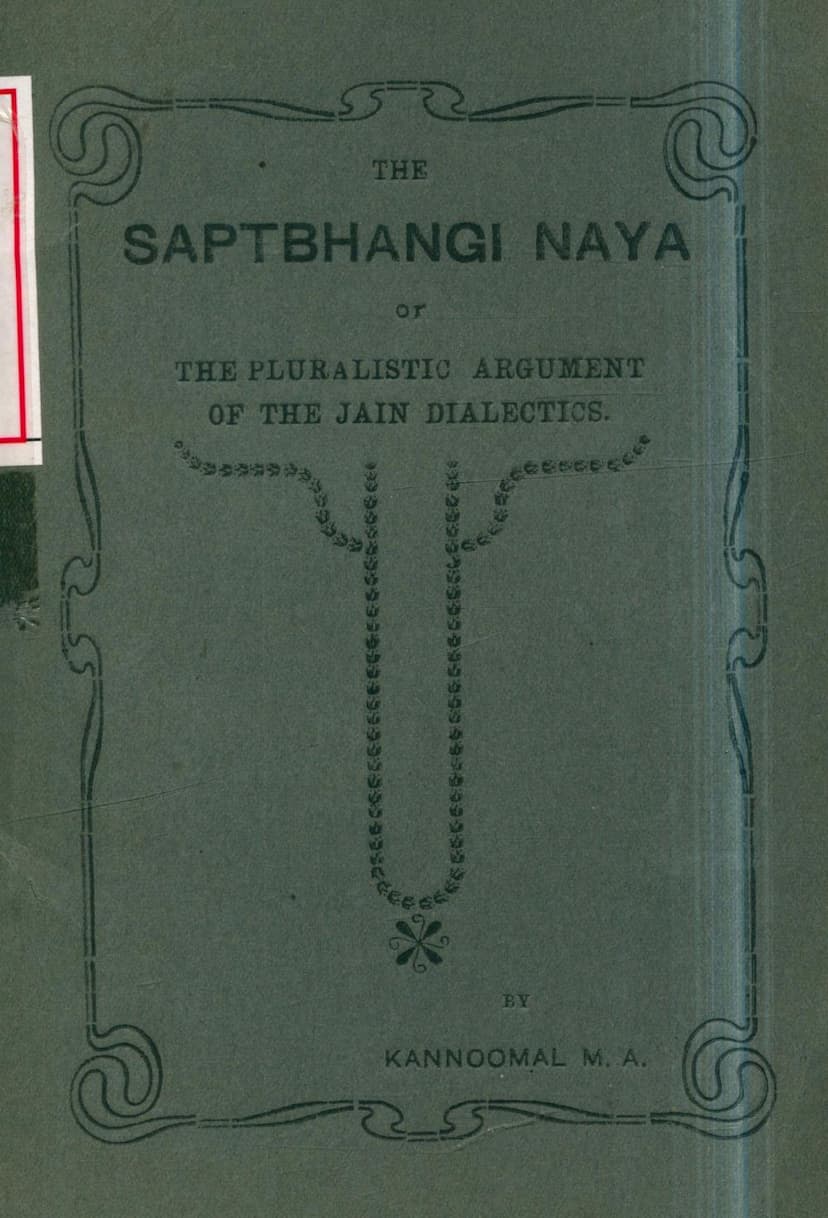Saptbhanginaya
Added to library: September 2, 2025

Summary
Here's a comprehensive summary of the Jain text "Saptbhangi Naya" by Kannomal:
The book "Saptbhangi Naya" by Lala Kannoomal M.A., published in 1917, explains a fundamental principle of Jain philosophy known as the Saptbhangi Naya, which translates to the Sevenfold Argument or the Pluralistic Argument of Jain Dialectics. The introduction by Shri Muni Jinvijayaji highlights Jainism's core doctrine of Anekāntavāda (non-absolutism or pluralism) and its specific articulation through Syādvāda (the doctrine of "perhaps" or "from a certain point of view").
Core Concepts:
- Anekāntavāda (Pluralism): This is the overarching principle that objects possess manifold qualities and can be viewed from an unlimited variety of perspectives. It acknowledges the relativity of knowledge.
- Syādvāda (The "Perhaps" Doctrine): This is the practical application of Anekāntavāda, where statements about reality are qualified with "Syāt" (perhaps, maybe, from a certain point of view). This avoids definitive, one-sided assertions and embraces the complexity of reality.
- Dravya (Substance) and Paryāya (Mode/Phenomenal Form): Jain philosophy distinguishes between the eternal, unchanging substance (Dravya) and the transient, changing phenomenal forms or modes (Paryāya) that the substance takes. All objects are eternal in their substance but non-eternal in their phenomenal aspects.
- Inter-relatedness: Every object is understood in relation to other objects. The knowledge of one thing inherently suggests the knowledge of its opposite or related concepts (e.g., knowing "man" implies knowing "non-man").
The Saptbhangi Naya (The Sevenfold Argument):
This is the method of examining an object from various viewpoints, reduced to seven distinct propositions or premises (Bhangas). The book uses the example of a "pot" to illustrate these propositions:
- Maybe it exists (Syāt asti): The pot exists in its own specific form, with its particular name, locality, matter, and time. This is a monistic perspective focusing on its inherent characteristics.
- Maybe it does not exist (Syāt nāsti): The pot does not exist from the perspective of the absence of its specific characteristics or in relation to other objects. For instance, it exists on a stone but not on a table. This is a pluralistic perspective focusing on its non-existence in other contexts.
- Maybe it exists and does not exist (Syāt asti nāsti): It exists in terms of its own inherent properties and simultaneously does not exist in relation to other objects or contexts. This combines the previous two viewpoints.
- Maybe it is indescribable (Syāt avaktavya): When attempting to describe the object by simultaneously considering both existence and non-existence (or contradictory aspects), it becomes difficult to assign a definitive quality, hence "indescribable."
- Maybe it exists and is indescribable (Syāt asti avaktavya): It exists in its material form, but when considered with its changing phenomenal forms, it becomes indescribable. This emphasizes existence while acknowledging its indescribability in certain complex combinations.
- Maybe it does not exist and is indescribable (Syāt nāsti avaktavya): It does not exist in its changing phenomenal forms, but if its material and phenomenal aspects are considered simultaneously, it becomes indescribable. This emphasizes non-existence while acknowledging indescribability.
- Maybe it exists, does not exist, and is indescribable (Syāt asti nāsti avaktavya): This is the most comprehensive statement, encompassing existence (material form), non-existence (phenomenal form), and the resulting indescribability when all these aspects are considered together.
Key Terms and Their Significance:
- 'Maybe' (Syāt): Signifies the pluralistic approach, allowing for multiple truths from different viewpoints.
- 'Existence': Encompasses eight modes of existence related to time, individual form, sense, relation, contributory part, receptivity, association, and word. These modes highlight the multifaceted nature of existence.
- 'Pot': Represents any object, analyzed in its material form (defined by name, locality, matter, time) and phenomenal form (characterized by change and absence of fixed factors).
Critique of Monism and Other Philosophies:
The book argues that philosophies adhering strictly to monism (seeing only one aspect) present an incomplete picture. It briefly analyzes how other philosophies like Sankhya, Buddhism, and Vedanta, by focusing on one dominant viewpoint, only capture a part of the truth, akin to the first few propositions of Saptbhangi Naya. For example:
- Sankhya: Focuses on primordial matter (material form), aligning with "Maybe it exists."
- Buddhism: Focuses on constant change (phenomenal form), aligning with "Maybe it does not exist."
Refutation of Objections:
The text addresses common criticisms against the pluralistic position:
- Fallacy of Chhal (Fraud): Denied because Saptbhangi Naya uses terms with consistent meaning from specific viewpoints, unlike ambiguous wordplay.
- Fallacy of Doubt: Refuted by explaining that the approach is not indecisiveness but a systematic examination of all aspects.
- Eight Fallacies of Contradiction: The author systematically refutes each potential contradiction by clarifying that the existence and non-existence are predicated from different, non-conflicting viewpoints, not in the same sense or receptacle.
Broader Implications:
The author suggests that the Saptbhangi Naya offers a valuable tool for reconciling seemingly conflicting religious and philosophical tenets in India. By embracing a pluralistic perspective, one can gain a more comprehensive and harmonious understanding of truth. The book concludes by noting that other philosophies, while not explicitly professing pluralism, implicitly accept it by acknowledging multiple aspects within a single substance.
In essence, "Saptbhangi Naya" by Kannomal is a clear and concise exposition of a core Jain logical framework that emphasizes the multifaceted nature of reality and the importance of considering multiple perspectives for a complete understanding. It presents a robust defense of Jain dialectics against common criticisms.